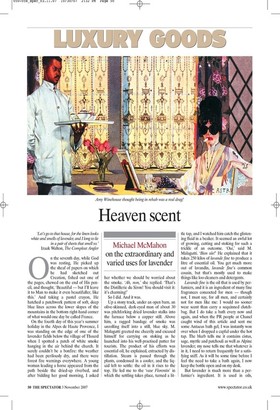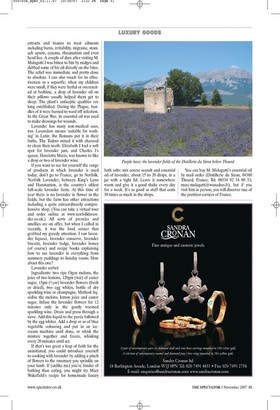Heaven scent
Michael McMahon on the extraordinary and varied uses for lavender 'Let's go to that house, for the linen looks white and smells of lavender; and I long to lie in a pair of sheets that smell so.' Izaak Walton, The Compleat Angler n the seventh day, while God was resting, He picked up the sheaf of papers on which he had sketched out Creation, fished out one of the pages, chewed on the end of His pencil, and thought, 'Beautiful — but I'll leave it to Man to make it even beautifuller, like this.' And taking a pastel crayon, He hatched a patchwork pattern of soft, deep blue lines across the lower slopes of the mountains in the bottom right-hand corner of what would one day be called France.
On the fourth day of this year's summer holiday in the Alpes de Haute Provence, I was standing on the edge of one of the lavender fields below the village of Thoard when I spotted a patch of white smoke hanging in the air behind the church. It surely couldn't be a bonfire: the weather had been perilously dry, and there were forest fire warnings everywhere. A young woman leading a horse appeared from the path beside the dried-up riverbed, and after bidding her good morning, I asked her whether we should be worried about the smoke. `Ah, non,' she replied. 'That's the Distillerie du Siron! You should visit it: it's charming!'
So I did. And it was.
Up a stony track, under an open barn, an olive-skinned, dark-eyed man of about 30 was pitchforking dried lavender stalks into the furnace below a copper still. Above him, a ragged bandage of smoke was unrolling itself into a still, blue sky. M. Malagutti greeted me cheerily and excused himself for carrying on stoking as he launched into his well-practised patter for tourists. The product of his efforts was essential oil, he explained, extracted by distillation. Steam is passed through the plants, condensed in a cooler, and the liquid left to settle: the oil in it rises to the top. He led me to the 'vase Florentin' in which the settling takes place, turned a little tap, and I watched him catch the glistening fluid in a beaker. It seemed an awful lot of growing, cutting and stoking for such a trickle of an outcome. `Oui,' said M. Malagutti. 'Bien sari' He explained that it takes 250 kilos of lavande fine to produce a litre of essential oil. You get much more out of lavandin, lavande fine's common cousin, but that's mostly used to make things like loo cleaners and detergents.
Lavande fine is the oil that is used by perfumiers, and it is an ingredient of many fine fragrances concocted for men — though not, I must say, for all men, and certainly not for men like me: I would no sooner wear scent than carry a sequinned clutchbag. But I do take a bath every now and again, and when the PR people at Chanel caught wind of this article and sent me some Antaeus bath gel, I was instantly won over when I dropped a capful under the hot tap. The blurb tells me it contains cistus, sage, myrtle and patchouli as well as Alpine lavender; my nose tells me that whatever is in it, I need to return frequently for a satisfying sniff. As it will be some time before I feel the need to take a bath again, I now keep the bottle open and on my desk.
But lavender is much more than a perfumier's ingredient. It is used in oils, extracts and tisanes to treat ailments including burns, irritability, migraine, stomach upsets, eczema, rheumatism and even head lice. A couple of days after visiting M. Malagutti I was bitten to bits by midges and dabbed some of his oil directly on the bites. The relief was immediate and pretty close to absolute. I can also vouch for its effectiveness as a soporific: when my children were small, if they were fretful or overexcited at bedtime, a drop of lavender oil on their pillows usually helped them get to sleep. The plant's antiseptic qualities are long established. During the Plague, bundles of it were burned to ward off infection. In the Great War, its essential oil was used to make dressings for wounds.
Lavender has many non-medical uses, too. Lavandum means 'suitable for washing' in Latin: the Romans put it in their baths. The Tudors mixed it with charcoal to clean their teeth. Elizabeth I had a soft spot for lavender jam, and Charles I's queen, Henrietta Maria, was known to like a drop or two of lavender wine.
If you want to see for yourself the range of products in which lavender is used today, don't go to France, go to Norfolk. Norfolk Lavender, between King's Lynn and Hunstanton, is the country's oldest full-scale lavender farm. At this time of year there is no lavender in flower in the fields, but the farm has other attractions including a quite extraordinarily comprehensive shop. (You can take a virtual tour and order online at www.norfolklavender.co.uk.) All sorts of prezzies and smellies are on offer, but when I called in recently, it was the food corner that grabbed my greedy attention. I saw lavender liqueur, lavender conserve, lavender biscuits, lavender fudge, lavender honey (of course) and recipe books explaining how to use lavender in everything from summery puddings to Sunday roasts. How about this one?
Lavender sorbet: Ingredients: two ripe Ogen melons, the juice of two lemons, 120gm (4oz) of caster sugar, 15gm (1/2oz) lavender flowers (fresh or dried), two egg whites, bottle of dry sparkling wine or champagne. Method: liquidise the melons, lemon juice and castor sugar. Infuse the lavender flowers for 12 minutes only in the gently warmed sparkling wine. Drain and press through a sieve. Add this liquid to the purée followed by the egg whites. Add a drop or so of blue vegetable colouring and put in an icecream machine until done, or whisk the mixture together and freeze, whisking every 20 minutes until set.
If that's too great a leap of faith for the uninitiated, you could introduce yourself to cooking with lavender by adding a pinch of flowers to the rosemary you sprinkle on your lamb. If (unlike me) you're fonder of bathing than eating, you might try Mary Wakefield's recipe for homemade luxury bath salts: mix coarse seasalt and essential oil of lavender, about 15 to 20 drops, in a jar with a tight lid. Leave it somewhere warm and give it a good shake every day for a week. It's as good as stuff that costs 50 times as much in the shops.
You can buy M. Malagutti's essential oil by mail order (Distillerie du Siron, 04380 Thoard, France; Tel. 00334 92 34 80 33; marc.malagutti@wanadoo.fr), but if you visit him in person, you will discover one of the prettiest corners of France.













































































 Previous page
Previous page